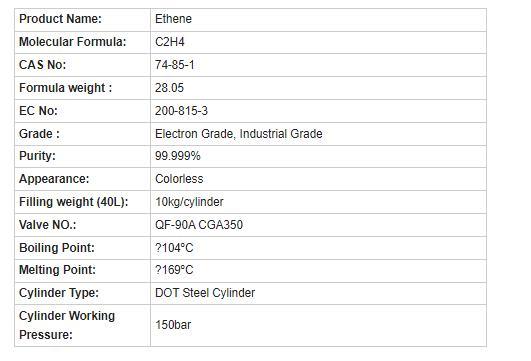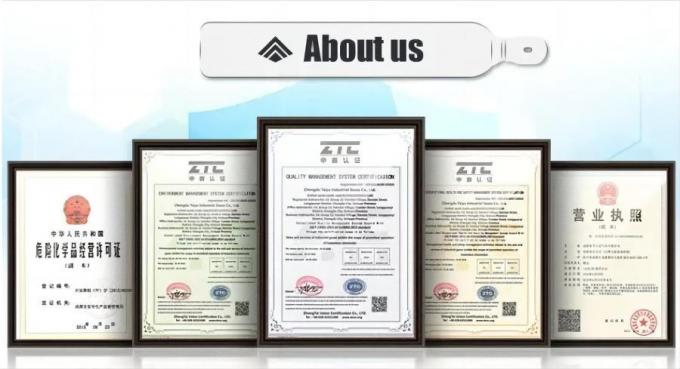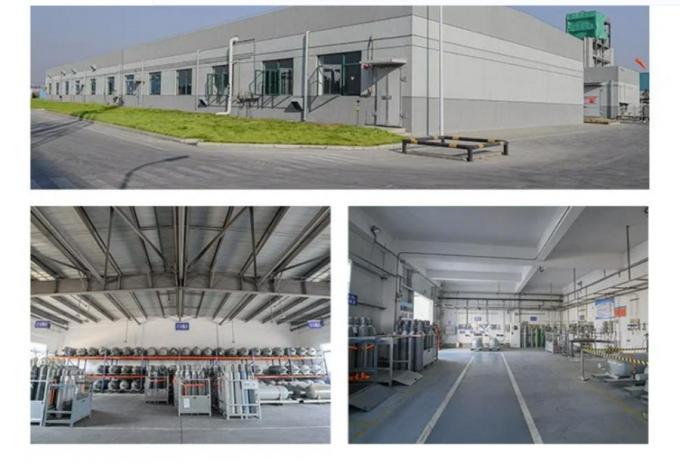


| MOQ: | 1kg |
| Price: | US $2/kg |
| Standard Packaging: | Cylinder/Tank |
| Delivery Period: | 15 days |
| Payment Method: | L/C, T/T |
| Supply Capacity: | 5000kg/month |
Ethylene gas (C2H4) is a colorless and flammable gas composed of two carbon atoms bonded to four hydrogen atoms. It is a naturally occurring plant hormone and is also produced industrially for various applications. Ethylene is involved in several important biological and industrial processes. Here are some key points about ethylene gas:
Plant Hormone: Ethylene is a naturally occurring plant hormone that regulates various physiological processes in plants. It influences fruit ripening, flower and seed development, leaf senescence (aging), and response to stress, such as drought or injury. Ethylene production in plants can be triggered by factors such as aging, hormonal signals, or environmental stimuli.
Industrial Production: Ethylene gas is produced on a large scale industrially through the steam cracking of hydrocarbon feedstocks, such as natural gas, naphtha, or ethane. Steam cracking involves heating the feedstock to high temperatures, breaking the carbon-carbon bonds, and producing a mixture of hydrocarbon gases, including ethylene.
Uses in Agriculture:
Fruit Ripening: Ethylene is widely used to ripen fruits artificially. Controlled exposure to ethylene gas accelerates the ripening process of climacteric fruits, such as bananas, tomatoes, and avocados.
Plant Growth Regulation: Ethylene can be used to control plant growth and development. It is employed to induce flowering in some plants, promote uniform fruit setting, and regulate the height of certain crops.
Post-Harvest Preservation: Ethylene is also used in post-harvest applications. For example, it can be used to trigger the release of ethylene in some fruits to enhance their uniform ripening during storage and transportation.
Other Industrial Applications:
Chemical Synthesis: Ethylene is a crucial building block for the production of various chemicals. It is used in the synthesis of plastics, such as polyethylene, as well as solvents, synthetic fibers, and other organic compounds.
Welding: Ethylene gas is occasionally used as a fuel gas in oxyfuel welding and cutting processes, although it is less common than acetylene.
Safety Considerations: Ethylene gas is flammable and should be handled with caution. Proper storage, handling, and ventilation practices should be followed to prevent the accumulation of flammable concentrations and minimize the risk of ignition. Ethylene gas cylinders should be stored and transported in compliance with safety regulations for flammable gases.
It's important to note that the use of ethylene gas in agriculture and industrial applications requires compliance with safety guidelines, regulations, and proper training to ensure the safe handling and storage of the gas.
Basic Info.
| Model No: | C2H4 | Transport Package | Cylinder |
| Specification: | 40L | Trademark | CMC |
| Origin: | Suzhou | HS Code | 2812190091 |
| Production Capacity: | 5000 Tons Per Month |
Specification:
 Product Applications:
Product Applications:
Chemicals: Ethylene is the starting material for several industrial syntheses. It is employed as an intermediate in the chemical industry and for the production of plastics.
Food & Beverages: An ethylene / nitrogen mixture supplied cylinders is used to control ripening of fruit, especially bananas. A concentration of a few ppm in the warehouse atmosphere is used. It is also used in agriculture to promote crop growth. In this application The gas is directly injected into the soil.
Glass: Ethylene is used in the production of specialty glass for the automotive industry (car glass).
Medical: Ethylene is used as an anaesthetic
Metal Fabrication: Ethylene is used as oxy-fuel gas in metal cutting, welding and high velocity thermal spraying
Refining: Ethylene is used as refrigerant, especially in LNG liquefaction plants.
Rubber & Plastics: Ethylene is used in the extraction of rubber.
Detailed Photo
![]()




| MOQ: | 1kg |
| Price: | US $2/kg |
| Standard Packaging: | Cylinder/Tank |
| Delivery Period: | 15 days |
| Payment Method: | L/C, T/T |
| Supply Capacity: | 5000kg/month |
Ethylene gas (C2H4) is a colorless and flammable gas composed of two carbon atoms bonded to four hydrogen atoms. It is a naturally occurring plant hormone and is also produced industrially for various applications. Ethylene is involved in several important biological and industrial processes. Here are some key points about ethylene gas:
Plant Hormone: Ethylene is a naturally occurring plant hormone that regulates various physiological processes in plants. It influences fruit ripening, flower and seed development, leaf senescence (aging), and response to stress, such as drought or injury. Ethylene production in plants can be triggered by factors such as aging, hormonal signals, or environmental stimuli.
Industrial Production: Ethylene gas is produced on a large scale industrially through the steam cracking of hydrocarbon feedstocks, such as natural gas, naphtha, or ethane. Steam cracking involves heating the feedstock to high temperatures, breaking the carbon-carbon bonds, and producing a mixture of hydrocarbon gases, including ethylene.
Uses in Agriculture:
Fruit Ripening: Ethylene is widely used to ripen fruits artificially. Controlled exposure to ethylene gas accelerates the ripening process of climacteric fruits, such as bananas, tomatoes, and avocados.
Plant Growth Regulation: Ethylene can be used to control plant growth and development. It is employed to induce flowering in some plants, promote uniform fruit setting, and regulate the height of certain crops.
Post-Harvest Preservation: Ethylene is also used in post-harvest applications. For example, it can be used to trigger the release of ethylene in some fruits to enhance their uniform ripening during storage and transportation.
Other Industrial Applications:
Chemical Synthesis: Ethylene is a crucial building block for the production of various chemicals. It is used in the synthesis of plastics, such as polyethylene, as well as solvents, synthetic fibers, and other organic compounds.
Welding: Ethylene gas is occasionally used as a fuel gas in oxyfuel welding and cutting processes, although it is less common than acetylene.
Safety Considerations: Ethylene gas is flammable and should be handled with caution. Proper storage, handling, and ventilation practices should be followed to prevent the accumulation of flammable concentrations and minimize the risk of ignition. Ethylene gas cylinders should be stored and transported in compliance with safety regulations for flammable gases.
It's important to note that the use of ethylene gas in agriculture and industrial applications requires compliance with safety guidelines, regulations, and proper training to ensure the safe handling and storage of the gas.
Basic Info.
| Model No: | C2H4 | Transport Package | Cylinder |
| Specification: | 40L | Trademark | CMC |
| Origin: | Suzhou | HS Code | 2812190091 |
| Production Capacity: | 5000 Tons Per Month |
Specification:
 Product Applications:
Product Applications:
Chemicals: Ethylene is the starting material for several industrial syntheses. It is employed as an intermediate in the chemical industry and for the production of plastics.
Food & Beverages: An ethylene / nitrogen mixture supplied cylinders is used to control ripening of fruit, especially bananas. A concentration of a few ppm in the warehouse atmosphere is used. It is also used in agriculture to promote crop growth. In this application The gas is directly injected into the soil.
Glass: Ethylene is used in the production of specialty glass for the automotive industry (car glass).
Medical: Ethylene is used as an anaesthetic
Metal Fabrication: Ethylene is used as oxy-fuel gas in metal cutting, welding and high velocity thermal spraying
Refining: Ethylene is used as refrigerant, especially in LNG liquefaction plants.
Rubber & Plastics: Ethylene is used in the extraction of rubber.
Detailed Photo
![]()


